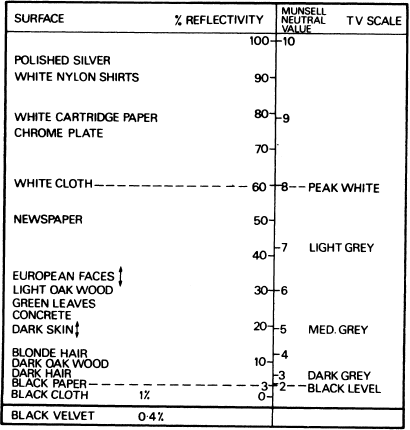Studio Scenery
The type and extent of scenery (staging) required depends on the scale and forms of production envisaged, and on available budgets. There are, however, several basic staging considerations that affect studio design. If the scenery is not sufficiently high, cameras are liable to shoot over it and reveal the studio beyond. To avoid this, the cameras’ shots would have to be restricted. For a 150 m2 studio, scenery 3 m (10 ft) high should be adequate for most situations. With smaller studios and fairly static situations, less height should suffice, e.g. 2.4 m (8 ft).
For studios on limited budgets, a carefully chosen assortment of stock items can provide useful economies. The paint, like all staging materials, must be fireproof and the range of colours used should be selected to provide good tonal variety.
Classifying colour
The Munsell system of colour classification can prove useful in determining the colour of paint to use to obtain adequate contrast on the monochrome picture. Colours with the same luminance value (brightness) on the Munsell colour charts appear approximately the same shade of grey in a monochrome picture provided the camera’s colour response is similar to that of the eye. Colours that have the same luminance value as the face (about 6 on the Munsell scale) should be avoided, especially in situations where the scenery and the artiste are lit with the same luminaire, or faces and backgrounds may merge.
Surface treatment
For small, relatively static set-ups, the scenery may often be reduced to a number of decorated sheets or flats which can be clipped to a rail. These can be changed easily and so avoid over-familiarity.
Hard-faced curved scenery should be used with caution—it can cause acoustical problems for sound pick-up.
Floors, when seen in shot, can be specially treated with washable paints. In colour studios care must be taken in choosing a fairly neutral finish, unless a special effect is required. Light reflected from a coloured floor can cause colour casts on the artistes. Where floors are to be painted with designs simulating parquet floors, tiles, etc. special machines incorporating large rollers can be used to provide rapid effective patterns.
Scenic storage and repair
A scenery store with good access to the studio is essential. Otherwise it can become necessary to move spare scenery around the studio just in order to make working floor space available. It should have adequate height to allow the scenery to be stored vertically.
A workshop area is normally needed for scenic construction, repair and painting. It should be well ventilated, and acoustically isolated from the studio.

Scenery needs to be about 3 m high if Long Shots are required, otherwise the camera will shoot off.

Reflectivity scale
Table relating the inherent reflectivities and the Munsell Scale. This illustrates the problem of working with camera tubes which have a restricted acceptable contrast ratio (30:1). A 20:1 contrast ratio inherent in the scene allows for extra contrast (modelling) added by lighting treatment.
